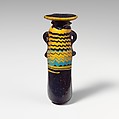Glass alabastron (perfume bottle)
Translucent blue, streaked with reddish purple, with handles in same color; trails in opaque yellow and opaque turquoise blue.
Broad, uneven horizontal rim-disk, with slightly raised edge around mouth, extending down over top of neck and trail decoration; short cylindrical neck; uneven rounded shoulder; straight-sided cylindrical body; convex bottom; two vertical ring handles with knobbed tails, applied over trail decoration.
Yellow trail attached at edge of rim-disk; a second yellow trail applied on neck and wound unevenly down in a spiral, then tooled into a close-set zigzag pattern; halfway down pattern a turquoise blue trail is added, mingling with yellow; immediately below this, a third fine yellow trail wound horizontally three and a half times around body.
Intact; slight dulling and some pitting holes.
Glass vessels such as these first appeared in the Greek world late in the sixth century B.C. They originally contained perfumes or scented oils used in funerary rites, after which the bottles were left in the grave.
Due to rights restrictions, this image cannot be enlarged, viewed at full screen, or downloaded.

